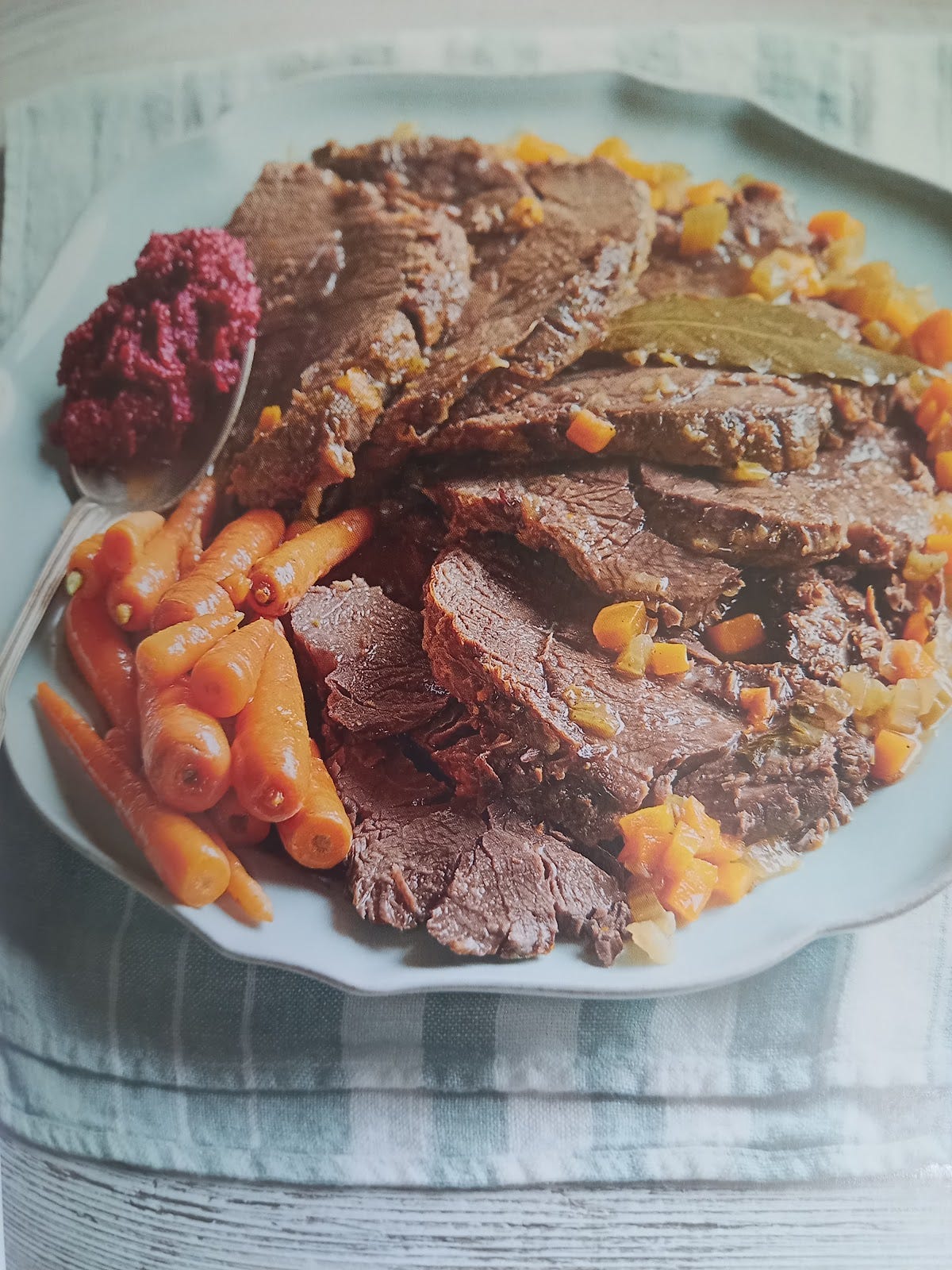The dirt vegetable you shouldn't hate
A recipe for beet, blue cheese, apples and walnuts salad
Find more newsletters with opinions and recipes here. If you want to take issue, please Comment.
Beets taste of soil. At least, that’s the usual complaint of detractors of the blameless beetroot. Like fresh coriander/cilantro, it’s a love-it-or-hate-it vegetable.
That its flavour is earthy is precisely the quality cited by its supporters. The distinct taste is caused by geosmin, an organic compound produced by microbes in the soil.
You may hate beetroot enough to avoid it. But you can’t. Beets are used to intensify the colour of tomato paste, sauces, desserts, jams and jellies, ice cream, sweets, and breakfast cereals. (Attention, please, Froot Loops developers and all other creators of candy masquerading as breakfast cereals and targetting kids:
Feel free to drop chemical Red40. Beetroot’s betanin is an effective and natural food colourant. Although, come to think of it, why not drop manufacturing your so-called ‘cereal’....)
In the 19th century, beetroot juice was even used to boost the colour of red wine. I’ve drunk a not-unquaffable wine made only from beetroot. It’s - um - earthy. It partners well with - um - a tastebud-numbing vindaloo.
If you can’t bear beets but are prepared to give them another chance, try them with an apple. Added to any dish containing beetroot, they act to counter that flavour of sod. The Germans who, like the Slavs, are avid fans of the beetroot, have a justly popular salad which involves grating a whole washed, unpeeled, beetroot with a whole washed, unpeeled but cored apple then seasoning it and dressing it with vinegar.
We should be more respectful of this garnet-coloured root. Every part of it is edible. The green leaves can be given the same treatment as spinach or added raw to salads when young.
Plus, it’s good for our health. It’s high in immune-boosting vitamin C, fibre, and minerals like potassium (essential for healthy nerve and muscle function) and manganese (good for bones, liver, kidneys, and pancreas). It also contains the B vitamin folate, believed to help reduce the risk of birth defects.
First domesticated by the Ancient Egyptians and Greeks for their leaves, it was the Romans who became interested in their roots. During the Renaissance, beetroot began to be used in treating digestive illnesses and blood conditions. 15th century Italian gastronomist and humanist Bartolomeo Sacchi, better known as Platina, recommended eating them with garlic to temper ‘garlic breath’. (Note he didn’t recommend simply not eating garlic.)
Beets are a versatile vegetable. Slices pickled in vinegar are eaten cold in Britain as a popular condiment. Plain slices were a key ingredient in the ghastly British salads of the 1950s cloaked in Salad Cream, leaking into companion quarters of hard-boiled egg and cucumber slivers. Even today they are one of Amazon’s Best Sellers, with 49 different jarred ways to buy them.
Fans eat them boiled, buttered, steamed, or roasted and dolloped in sour cream - a dish in Russia which goes well with game and which might also include mushrooms, carrots and onions. It's so beloved it's often eaten on its own with black bread. In Australia, a slice of pickled beetroot is served on hamburgers. Gives you pause for thought, eh? But surely an arresting variation on the tomato. The Dutch marinate boiled eggs in pickled beet juice, to turn them a vivid crimson.
To make ‘xhrain’, a condiment popular in Russian, Ukrainian, Polish, Hungarian, Lithuanian and Ashkenazi Jewish cuisine, grated horseradish is folded into grated beetroot. Seasoned with vinegar and salt, it’s served with meat and cold cuts - even added to sandwiches. In Moscow, I would hoard jars of it to add zing to the bland repetitive meals of Soviet deprivation. It makes a fine accompaniment to French Boeuf à la Mode or pot roast.
Of course, you wouldn’t want to go overboard with your beetroot consumption or you would risk lovely-in-name-only ‘mangel-wurzel’ disease, as did thousands of beet-eating Europeans during the food shortages that followed the First World War. And if you do over-indulge, the colour of the water in the lavatory bowl the morning after will shock you awake.
I offer all this to try and persuade detractors to give the beetroot another chance. There are so many ways it can be used, from Russia’s comforting winter borscht soup to the simpler, refreshing, jewel-beautiful, cold beetroot soup of summer, as well as a salad contrived with slices of different varieties and colours of beetroot, such as the internally-striped chioggia originally from Italy, and golden beetroots.
Here is a summer lunch recipe that should impress any doubters with just how well an apple can complement beetroot.
8 small to medium beets, washed well, tails and leaves removed
45g/1 ½ oz chopped walnuts
1 head butter lettuce, cored and separated into individual leaves
½ small to medium cored red apple, cut into thin slices
125/4 ½ oz grams blue cheese, pulled or crumbled into small nuggets (optional but nice)
2 tablespoons balsamic vinegar
1 teaspoon Dijon mustard
1 teaspoon honey
5 tablespoons olive oil*
salt and freshly ground black pepper to taste
Make the salad dressing by placing the last five ingredients in a small jar. Put the lid on the jar and shake it to blend the dressing. Set aside till needed.
Place the beetroots in a pot and cover with about 10 cms/4 ins of cold water. Set over medium-high heat and bring to a boil. Reduce the heat until the water is gently simmering. Simmer them until tender, about 30 minutes.
Drain the beetroots well. Fill the pot again with cold water to cool the beetroots then peel them. Cut them in half, head to tail, then thinly slice and store in a bowl. Drizzle over a little of re-shaken vinaigrette dressing, toss gently then cover and refrigerate until ready to serve the salad.
Heat a heavy dry frying pan over medium heat. Add the walnuts to the pan and keep tossing them until they are lightly toasted, two to three minutes. Don’t let them blacken or they will taste bitter. Remove them from the heat.
Tearing the larger leaves into smaller pieces as needed, lightly dress the butter lettuce with vinaigrette, toss, and divide and mound in the centre of each of four plates. Top with the beets, followed by the apples, walnuts and cheese. Layering like this stops the beets leaking into the other elements. Drizzle each salad with a little more of the shaken vinaigrette, and serve.
*I know I put 5 tablespoons of olive oil. But one trick I learned interviewing chefs is they rarely use olive oil except as a flavouring. So 3 or 4 tablespoons of a bland vegetable oil plus 1 or 2 tablespoons of extra virgin olive oil is how they make a vinaigrette, particularly when they're using mustard.








Oh my goodness, Julia, this sounds SO DELICIOUS. I love beetroot BECAUSE it tastes like soil. It is one of the most wondrous vegetables on earth. Your newsletter is so great, and I am inspired to eat a beetroot salad as soon as I can be bothered to get off my bum and get some fresh beet from the shop. <3
I remember those limp green salads with the beetroot slice dripping all over the leaves... definitely took time to appreciate this delicious vegetable.